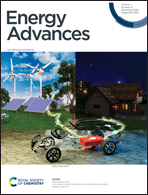High specific capacity and mechanism of a metal–organic framework based cathode for aqueous zinc-ion batteries†
Abstract
Rechargeable aqueous zinc-ion batteries (AZIBs) are promising for large-scale energy storage due to their high safety and low cost but the reported cathode materials still suffer from limited specific capacities and poor cycle performance. Herein, the Mn-based metal–organic framework (MOF), MOF-73, is used for the first time to make a novel cathode for AZIBs and its great capacity enhancement mechanism is investigated. Results show that MOF-73 can render a voltage plateau of ∼1.45 V and induce manganese ions to co-contribute a high-specific capacity of 815 mA h g−1 (0.84 mA h cm−2). This work sheds light on the fundamentals of the electrochemical zinc energy storage of MOFs while holding great promise for exploring novel MOFs as cathodes for AZIBs.

- This article is part of the themed collection: Energy Advances: Highlight China


 Please wait while we load your content...
Please wait while we load your content...